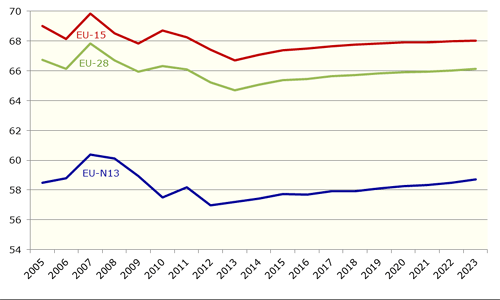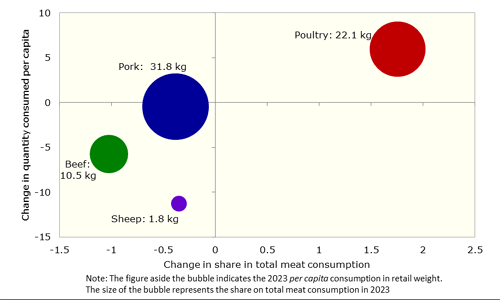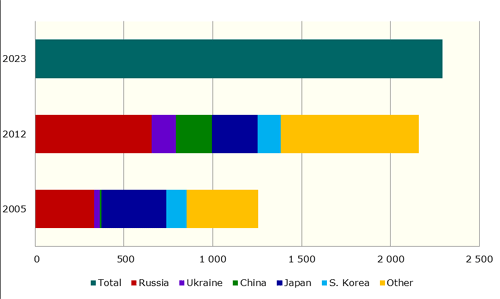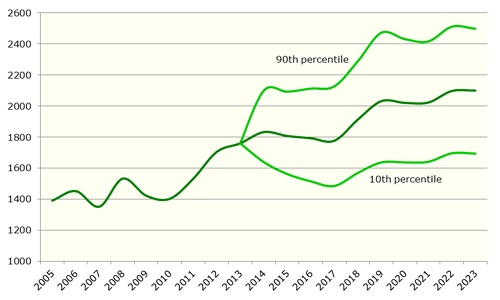



Meat Products in the European Union 2013-2023
Pork will remain the favourite meat in the European Union but per-capita consumption has been declining in recent years, as have pig numbers in the region, according to a new European Commission report entitled 'Prospects for Agricultural Markets and Income in the EU 2013-2023'.
The EU meat sector is expected to be supported by strong demand on the world market driven by favourable economic conditions. In Europe, prospects of improved economic growth should leave consumers with more disposable income allowing for a higher consumption of meat products.
In 2012, unfavourable weather in several parts of the world (drought in the US, Black Sea region and Eastern Europe) drove up grain, and consequently feed prices, which affected meat production and put pressure on margins despite meat prices reaching historical highs worldwide in 2012 and 2013.
In the current outlook, feed prices are expected to remain relatively high throughout the projection period, though significantly below 2012 levels. Projected meat prices are also to remain firm due to strong world demand and limited supply response.

EU meat demand: poultry meat to grow the fastest but at a slower pace than previously
Lower availabilities, higher meat prices and the ongoing economic downturn with high unemployment rates especially in the southern European countries meant that overall meat consumption contracted in 2012 and 2013 (-1.5 per cent from 2011), reaching its lowest level for the past 11 years (64.7kg per capita)5 in 2013, as consumers turned to cheaper meats and cuts.
5 Consumption per capita is measured in retail weight. Coefficients to convert the carcass weight into retail weight are 0.7 for beef and veal, 0.78 for pig meat and 0.88 for poultry and sheep meat.
Consumption is expected to recover from 2014 as more meat comes in onto the market. By the end of the projection period, per-capita consumption is expected to reach 66.1 kg, similar to the 2011 level (Figure 1). The recovery is moderate because more people are changing their food habits towards more fish and/or ’less meat’ in their diets.
Individuals typically consume around 10kg more meat in the EU-15 than in the EU-N13 but this gap is expected to narrow slightly in the next few years, due mainly to faster growing poultry meat consumption in the new Member States. Current EU-15 and EU-N13 per capita consumption levels of pork, poultry and sheep meat are quite similar, but individuals in the EU-15 tend to eat far more beef: about 12kg as against 4kg in the EU-N13.

Over the projection period, poultry meat is expected to remain the most dynamic product (thanks to its price, convenience and health considerations) and partially compensate for falling beef and sheep meat consumption. Poultry consumption is expected to increase both as a proportion of total meat consumption and in absolute terms (Figure 2). Pork will remain Europe's favourite meat, while the consumption of beef and sheep meat is projected to drop in both in absolute and relative terms.
Pig Meat
Recent developments
Like the cattle herd, the pig herd has been decreasing since 2006 and stood at 147 million head in 2012 - a reduction of 16 million head or 10 per cent in seven years - while breeding sow numbers fell even more steeply, by 19 per cent (three million head). The downward trend is explained by:
- restructuring process in some of the most important producers
- increased productivity
- higher feed costs
- lower profitability in the sector, and
- (more recently) the need to adapt to new welfare rules.
In spite of the decline in herd, carcass weight gains implied that meat production increased slightly in the period to 2011. However, the new welfare rules in place accelerated the decline in animal numbers (as reflected in the December 2011 and 2012 surveys) and inevitably led to shorter supply on the European market in 2012 and 2013 (by -2 per cent and -1.2 per cent, respectively).
Despite this, exports performed relatively well in 2012 and 2013, with higher volumes (around 2.2 million tonnes) shipped to Asia and the Far East countries in particular; Russia remained the top destination (more than 600,000 tonnes per year), with second place going to Japan (over 250,000 tonnes per year).
Supply shortages and high prices put pressure on consumption, which fell by 2.3 per cent in 2012 and 1.1 per cent in 2013. Per-capita consumption fell significantly from 32.1kg (retail weight) in 2011 to 30.8kg in 2013.
Market outlook: rebound in production as of 2015 to benefit from export opportunities
It is expected that the new welfare rules will force some less competitive farmers out of production and a higher proportion of pig meat will come from more productive farms. This is expected to boost production from 2014 onwards to 23.4 million tonnes by 2023 (+2.8 per cent against the 2010-12 average; Figure 3).
The increase will be kept at moderate levels by environmental constraints in some of the main producing countries, e.g. the Netherlands and some parts of France.

Exports7 are projected to increase by 2023 by 12.4 per cent against the 2010-12 average and 6.3 per cent against 2012 levels (Figure 4). The annual growth of one per cent for 2012-23 is substantially lower than the corresponding rate for 2001-11 (+6 per cent). This development should be driven by increased competition from the US and Brazil, where production is likely to increase over the projection period - by 18 per cent and 24 per cent, repectively, by 2023 as compared with 2010-13 average.
Russia and China are expected to remain the main destinations for EU pig meat exports with a projected increase of the Chinese import demand. It is important to bear in mind that, if the Chinese authorities would lower their self-sufficiency objectives, the impact could be significantly higher imported quantities; for example, if in 2012, self-sufficiency objectives would have been one per cent lower, that could have implied additional pig meat imports of around 500,000 tonnes. On the other hand, higher domestic production - thanks to generous subsidies in pig meat production - might reduce import demand in Russia.
Over the projection period, consumption is expected to recover slowly from the very low 2013 level, reversing the decreasing trend observed since 2007 because of the economic crisis and the limited supply. However, even under this condition, consumption is still not expected to exceed 31.8kg per capita by 2023, which would keept it below the 2011 level.
7 Offal and fat (except lard) are not taken into account.


Tight supply and higher grain prices led pig meat prices in 2012 and the first part of 2013 well above their 2011 level (which was already a record); they subsequently fell somewhat in the second half of 2013 on the back of lower feed prices.
Over the outlook period, EU pig meat prices should follow developments on the world market and could rise at the same pace as in the past decade to reach €2,100 per tonne in 2023 (Figure 5).
However, uncertainties relating to crop yield and the macroeconomic environment could imply price fluctuation around their projected average level by up to nine per cent with a consequent impact on EU export competitiveness and demand.
January 2014








